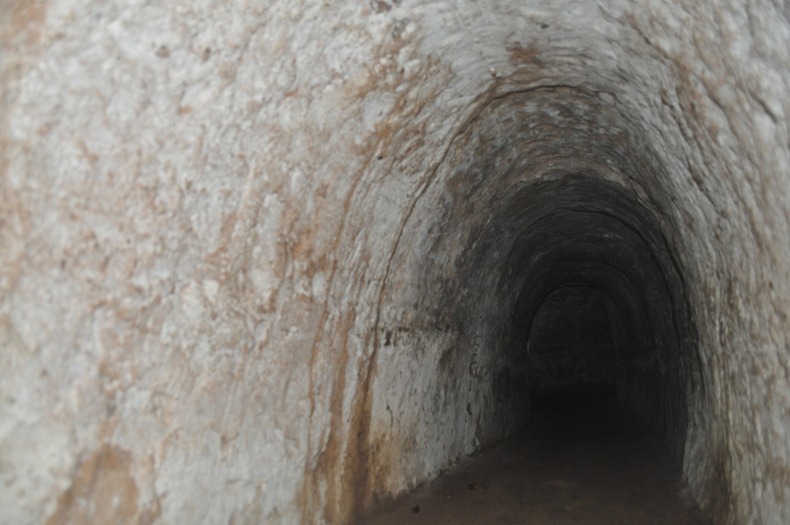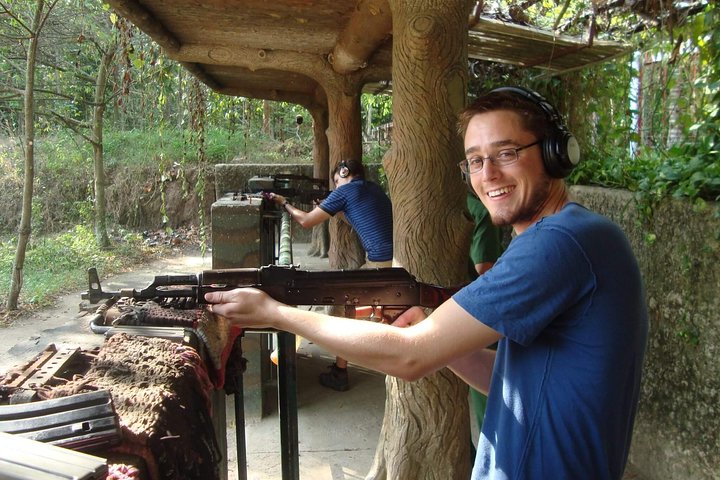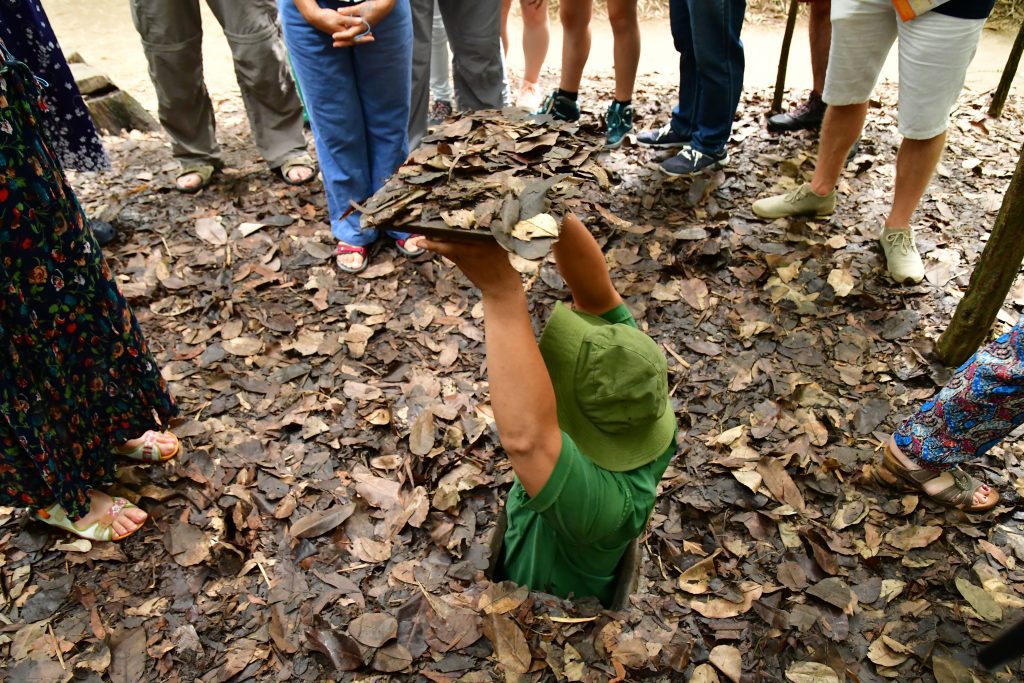Table of Contents
The Cu Chi Tunnel System is a remarkable feat of engineering and a symbol of the unwavering determination and resourcefulness of the Vietnamese people. Located in the Cu Chi district, just 70 kilometers northwest of Ho Chi Minh City, these underground passages played a crucial role in the Vietnam War. In this article, we will delve into the history, construction, strategic importance, life inside, tactics and weapons used, impact, tourism and preservation, challenges faced, comparison with other tunnel systems, and legacy of the Cu Chi Tunnel System.
History of the Cu Chi Tunnel System

In the early 1940s, as the resistance against French colonial rule began to gain momentum, the Viet Cong recognized the strategic value of the dense jungle terrain of Cu Chi. They envisioned a network of tunnels that would serve as a sanctuary, supply route, and base for guerrilla warfare against the French forces. The villagers of Cu Chi, who were mostly farmers and peasants, were called upon to assist in the construction of these tunnels.
Construction and Design of the Cu Chi Tunnels
With rudimentary tools such as shovels, hoes, and baskets, the villagers began the arduous task of excavating the tunnels. The soil in Cu Chi was soft and easy to dig, but it also posed a challenge as it was prone to collapse. To prevent this, the villagers used bamboo and wood to reinforce the walls and ceilings of the tunnels. They also strategically placed trapdoors and booby traps to defend against enemy attacks.
The tunnels were built in three levels – the first level was shallow and used for storage and living quarters, the second level was deeper and used for cooking and sleeping, and the third level was the deepest and served as a hiding place during bombings. The tunnels were also equipped with ventilation shafts, wells for drinking water, and secret entrances to confuse the enemy.
Strategic Importance of the Cu Chi Tunnel System

The Cu Chi Tunnel System played a crucial role in the Vietnam War. It served as a base for the Viet Cong to launch surprise attacks on the US and South Vietnamese forces. The tunnels also provided a safe haven for the Viet Cong to hide and regroup after an attack. The strategic location of the tunnels, which were spread over 250 kilometers, allowed the Viet Cong to move undetected between villages, making it difficult for the enemy to track them.
Life in the Cu Chi Tunnels during the Vietnam War
Life in the Cu Chi Tunnels was harsh and challenging. The cramped and dark conditions made it difficult for the Viet Cong fighters to move around, and they had to crawl on their hands and knees most of the time. The lack of proper ventilation and sanitation led to health issues such as respiratory problems and skin diseases. The constant fear of being discovered by the enemy also took a toll on the mental well-being of the fighters.
Despite these challenges, the Viet Cong soldiers adapted to life in the tunnels and developed ingenious ways to survive. They used bamboo shoots to create air holes and camouflaged the entrances with leaves and branches to avoid detection. They also grew vegetables and raised livestock in the tunnels to sustain themselves.
Tactics and Weapons used by the Viet Cong in the Cu Chi Tunnels

The Viet Cong employed various tactics and weapons to defend the Cu Chi Tunnel System. One of the most effective tactics was the use of booby traps. These traps were designed to maim or kill the enemy and were often hidden in the ground, trees, or inside the tunnels. Some of the commonly used traps included punji sticks, tripwires, and grenade traps.
The Viet Cong also used guerrilla warfare tactics, such as hit-and-run attacks, ambushes, and sabotage, to weaken the enemy’s morale and disrupt their operations. They also had a vast network of spies who provided them with valuable information about the enemy’s movements.
In terms of weapons, the Viet Cong relied on AK-47 rifles, grenades, and homemade weapons such as bamboo spears and crossbows. They also used tunnels to launch surprise attacks on the enemy, giving them an advantage in close combat.
Impact of the Cu Chi Tunnel System on the Vietnam War

The Cu Chi Tunnel System had a significant impact on the outcome of the Vietnam War. The tunnels allowed the Viet Cong to maintain a strong presence in the region and launch surprise attacks on the enemy. The US and South Vietnamese forces were unable to defeat the Viet Cong despite having superior firepower and technology. The tunnels also served as a symbol of the resilience and determination of the Vietnamese people in their fight for independence.
Tourism and Preservation of the Cu Chi Tunnels

Today, the Cu Chi Tunnel System has been preserved and turned into a popular tourist attraction. Visitors can explore a section of the tunnels and get a glimpse into the life of the Viet Cong fighters during the war. The tunnels have been widened to accommodate tourists, but they still retain their original structure and design.
However, the preservation of the tunnels has not been without its challenges. The humid climate and soft soil make it difficult to maintain the tunnels, and they require constant repairs and reinforcements. There is also a risk of collapse due to the high number of visitors. To address these issues, the management has limited the number of visitors per day and implemented strict rules to ensure the safety of both visitors and the tunnels.
Challenges faced by the Viet Cong in building and maintaining the Cu Chi Tunnels
Building and maintaining the Cu Chi Tunnels was no easy feat for the Viet Cong. They faced numerous challenges, including the constant threat of being discovered by the enemy, lack of proper tools and equipment, and health issues caused by the harsh living conditions. The tunnels also required constant repairs and reinforcements, which put a strain on the already limited resources of the Viet Cong.
Despite these challenges, the Viet Cong persevered and continued to expand and improve the tunnel system throughout the war.
Comparison between the Cu Chi Tunnel System and other tunnel systems

The Cu Chi Tunnel System is often compared to other tunnel systems, such as the Ho Chi Minh Trail and the Viet Cong’s underground base at Vinh Moc. While all these tunnel systems played a crucial role in the Vietnam War, there are some key differences between them.
The Ho Chi Minh Trail was a network of roads and paths that connected North and South Vietnam, allowing the Viet Cong to transport supplies and troops. It was not as well-hidden as the Cu Chi Tunnels and was frequently targeted by US airstrikes.
The underground base at Vinh Moc was built to shelter civilians from the bombings. It was larger and more complex than the Cu Chi Tunnels and had multiple levels, including a hospital, a school, and a maternity ward.
Legacy of the Cu Chi Tunnel System in Vietnam

The Cu Chi Tunnel System has become a symbol of Vietnamese resilience and ingenuity. It is a testament to the determination of the Vietnamese people to protect their land and fight for their freedom. The tunnels have been recognized as a national historical site by the Vietnamese government and are a source of pride for the country.
The legacy of the Cu Chi Tunnel System also extends beyond Vietnam. It has inspired other countries to build similar tunnel systems, and its tactics and strategies have been studied and emulated by military forces around the world.
Conclusion

The Cu Chi Tunnel System is a remarkable feat of engineering and a testament to the resilience and ingenuity of the Vietnamese people. It played a crucial role in the Vietnam War and has left a lasting impact on the country’s history and culture. Today, it stands as a reminder of the sacrifices made by the Vietnamese people in their fight for independence. The Cu Chi Tunnels are a must-visit for anyone interested in learning about the Vietnam War and experiencing a piece of history firsthand.